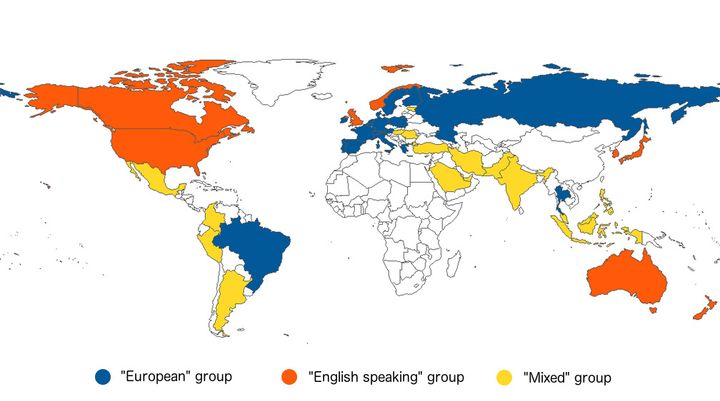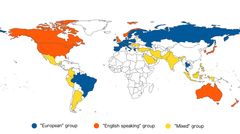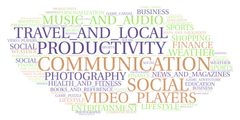New research shows what influences the types of apps you use

Researchers from Ireland, Finland and the UK have just published a research paper that gives an insight into global populations with the type of apps they use. They find that the country a person lives in is the single most important factor when it comes to influencing the kinds of apps they use.
“We wanted to study factors that govern usage of the mobile apps, particularly the role of geographic, demographic, and cultural values. We carried out a large-scale analysis of geographic, cultural, and demographic factors in mobile usage. We studied the data of 25,323 Android users who used 54,776 mobile applications in 44 countries across Europe, Americas, Asia and Oceania”, PhD Ella Peltonen of Ireland’s Insight Centre for Data Analytics says.
This kind of research is getting more important, since mobile devices and mobile apps have become an integral part of everyday life. There is a mobile app to support practically any kind of everyday activity be it well-being, education, health, or leisure. Smartphones have become hugely popular across the world, and thanks to a wide range of pricing options, they are affordable to most populations.
What the researchers found
According to the fresh results English-speaking countries, including the USA, the UK, Australia, Canada and New Zealand, along with Japan and South Korea had the highest app usage across the board. This is probably due to the fact that almost all apps have an English language version. In addition, many services and businesses in the USA and Europe have dedicated apps which boosts usage in these regions.
The group nicknamed “European” countries – Continental Europe, as well as Southern and Central European and Nordic countries – have lower app usage than the English-speaking countries, but higher than “Mixed” countries. Thailand and Singapore also fell into the “European” group for app usage, possibly because they are popular holiday destinations for Europeans.
The lowest app usage was in the “Mixed” group of countries: Argentina, the United Arab Emirates, Saudi Arabia, Qatar, Pakistan and India. In these groups, application usage in general was slightly lower than in the other groups, but higher in Sports and Racing Games.
How do the culture and values of a country influence the apps its population uses?
In the present work, the researchers compared Hofstede’s five factors to countries’ application usage. Hofstede’s cultural value survey provides a widely used, if not perfect, way to present cultural values of the population, according to the researchers here.
They found that "masculine" cultures (with more pronounced gender roles) like Japan prefer Personalization apps, while “collectivist” cultures and those with more fluid gender roles such as Russia seem to value Family related categories, Education games, and Parenting.
“Individualist” cultures such as the US favoured Entertainment applications and other leisure related categories, such as Travel and Local, Sports, Health and Fitness, and Music and Audio.
Socio-economic factors behind the mobile usage
App usage is not only dictated by the country you live in. Socio-economic factors play an important role when considering mobile usage.
The present study shows that occupation, education, and how much a person has in savings, are the next important factors in determining what apps a person will use. Those factors trump age and gender, for example.
People of similar socio-economic status tend to use their smartphones in a similar way across the globe. This is particularly true for people of similar household status, living with or without children, who tend to use smartphones in a similar way. This is also true for professionals and well-educated people.
“The results of our work show that there is a strong relationship between the type of apps people use and their geographic and socio-economic factors, suggesting that these different factors should be taken into account when studying mobile data. In addition, our results can be used to better target mobile apps in different countries, and for personalization,” Ella Peltonen says.
Images: Ella Peltonen
Source:
The article “The Hidden Image of Mobile apps: Geographic, Demographic, and Cultural Factors in Mobile Usage” is a collaboration work between University of Helsinki, Finland, University College Cork, Ireland, Lancaster University and University College London, UK. It was presented and published in the 20th International ACM Conference on Human-Computer Interaction with Mobile Devices and Services (ACM MobileHCI 2018, https://mobilehci.acm.org/2018/), in September, 2018, in Barcelona.
Pre-print of the article is available here: https://www.cs.helsinki.fi/group/carat/pubs/mobilehci18.pdf
Read more about The Carat project that combines expertise from mobile application development, statistical data analysis, and mobile energy awareness maintained by the University of Helsinki. Also The Carat team is introduced: http://carat.cs.helsinki.fi/
More information about the research article is given by Ella Peltonen, ella.peltonen@insight-centre.org
Also read: Are apps abusing your smartphone battery?: https://www.helsinki.fi/en/news/data-science/are-apps-abusing-your-smartphone-battery
Contact information at the University of Helsinki:
PhD Eemil Lagerspetz, Postdoctoral Researcher, Department of Computer Science, +358 50 4480 114, eemil.lagerspetz@helsinki.fi
Contacts
Minna Meriläinen-TenhuScience communicator
Tel:+358 50 415 0316minna.merilainen@helsinki.fiImages
Links
About Helsingin yliopisto
 Helsingin yliopisto
Helsingin yliopistoPL 3
00014 Helsingin yliopisto
02941 22622 (mediapalvelu) 02941 911 (vaihde) (vaihde)https://www.helsinki.fi/fi/yliopisto
Helsingin yliopisto on yli 40 000 opiskelijan ja työntekijän kansainvälinen yhteisö, joka tuottaa tieteen voimalla kestävää tulevaisuutta koko maailman parhaaksi. Kansainvälisissä yliopistovertailuissa Helsingin yliopisto sijoittuu maailman parhaan yhden prosentin joukkoon. Monitieteinen yliopisto toimii neljällä kampuksella Helsingissä sekä Lahden, Mikkelin ja Seinäjoen yliopistokeskuksissa. Lisäksi sillä on kuusi tutkimusasemaa eri puolilla Suomea ja yksi Keniassa. Yliopisto on perustettu vuonna 1640.
Subscribe to releases from Helsingin yliopisto
Subscribe to all the latest releases from Helsingin yliopisto by registering your e-mail address below. You can unsubscribe at any time.
Latest releases from Helsingin yliopisto
Kadotus vai toivo? Kolminaisuus pelastaa kaikki15.12.2025 11:25:44 EET | Tiedote
Eri uskonnoissa ja kristinuskon sisällä on hyvin monenlaisia käsityksiä ihmiskunnan lopullisesta kohtalosta. Tutkija, pastori Petri Tikan väitöstutkimus hakee vastausta kysymykseen kolminaisuusopista.
Ikääntyneiden ulkomailla syntyneiden syöpäkuolleisuus Suomessa syntyneitä matalampaa11.12.2025 08:30:00 EET | Tiedote
Suomessa asuvien ikääntyneiden maahanmuuttajien syöpäkuolleisuus on kokonaisuutena alhaisempi kuin Suomessa syntyneiden samanikäisten. Tietyissä syövissä kuolleisuus on kuitenkin korkeampaa.
Laajin tutkimus suomalaisnuorten ilmastoahdistuksesta: toivon ylläpitäminen avainasemassa11.12.2025 08:02:00 EET | Tiedote
Pelkkä ympäristövastuullinen käyttäytyminen voi lisätä nuoren ilmastoahdistusta, sillä ilmastonmuutosta ei voi yhden ihmisen voimin ratkaista. Sen sijaan nuorten toivoa ja uskoa yhteisöjen kykyyn toimia tulisi vahvistaa.
Koronarokotteet suojasivat erityisesti vaikealta koronataudilta11.12.2025 07:14:12 EET | Tiedote
Koronarokotteet tehosivat kaikissa ikäryhmissä ja vähensivät merkittävästi sairaalahoitoon ja tehohoitoon joutumista.
Ilmakuvista voidaan tekoälyn avulla saada tarkkaa tietoa metsien monimuotoisuudesta10.12.2025 09:40:07 EET | Tiedote
Metsien monimuotoisuudelle tärkeät haapapuut ja pystyyn kuolleet kelot voidaan tunnistaa luotettavasti avoimesta ilmakuva-aineistosta Helsingin ja Itä-Suomen yliopiston tutkijoiden kehittämillä menetelmillä.
In our pressroom you can read all our latest releases, find our press contacts, images, documents and other relevant information about us.
Visit our pressroom

